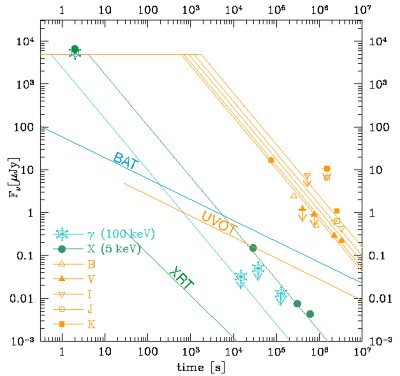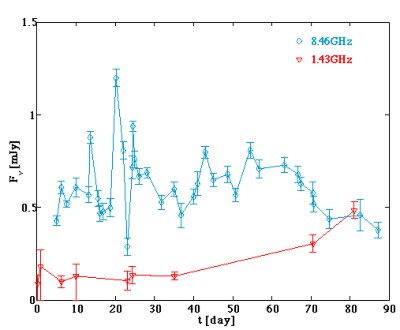How Does the Blast Wave Evolve and Interact with its Surroundings?
A GRB afterglow is thought to be produced by the interaction of an ultra-relativistic blastwave with the interstellar or intergalactic medium. The afterglow model predicts a series of stages as the wave slows. A key prediction is a break in the spectrum that moves from the gamma to the optical band, and is responsible for a change in the power law decay of the source flux. This break moves through the X-ray band in a few seconds but takes up to 1000 s to reach the optical. Thus, observations within the first 1000 s in the optical and ultraviolet are crucial to see this early phase. While it now seems likely that all the GRBs have X-ray afterglows, not all have bright optical afterglows. This may be due to optical extinction, but it is also possible that in some cases the optical afterglow is present but decays much more rapidly and is a function of the density of the local environment. Prompt high-quality X-ray, ultraviolet, and optical observations over the first minutes to hours of the afterglow (inaccessible without Swift) are crucial to resolving this question. Continuous monitoring for hours and days is then important to observe flares, spectral breaks, and geometric effects in the afterglow.

Whatever the progenitor, gamma rays and the afterglow are believed to be produced by material moving at hyper-relativistic speeds, with initial Lorentz factor of around 1000. The material slows down as it interacts with surrounding medium. Starting from an initial radius of one million centimeters, the fireball has expanded to a distance of 3 x 1012 cm after 100 seconds. The burst is seen as the shock forms at a distance of 1014 cm in about 3000 seconds, and the afterglow occurs at a distance of 3 x 1016 cm after about a million seconds. The afterglow radiation is seen at all wavelengths from X-ray to radio.
Sensitivity to Afterglows

Sensitivity of Swift instruments (5σ, Δt/t = 1) compared to measured and fitted (Wijers, Rees, & Meszaros, 1997) light curves for GRB 980228. The Swift instruments are much more sensitive than previous measurements.

Radio emission and scintillation probes interaction of fireball with surrounding medium.
Star-forming regions are embedded in large columns of neutral gas and dust. The presence of extinction, whether in the host or in foreground objects, can be readily determined by multi-band photometry in the optical and infrared. The simultaneous detection of high X-ray absorption, coupled with photometric EB-V measurements with Swift will determine whether dust and gas are present. Continuous monitoring over the first few hours to days will indicate whether dust is building up (due to condensation out of an expanding hot wind) or disappearing (due to ablation and evaporation).
The size of a causally connected emitting surface scales with the typical temporal variations seen in a burst (Δt ∼ 1 s) whereas the size of the blast wave surface scales as t. Internal shocks are believed to be the photon source during the GRB phase because the observed time variability (Δt/t ∼ 10-2 ) implies a smaller surface than made by external shocks. Some X-ray afterglows show Δt/t ∼ 1 (GRB 970508) but others show Δt/t ∼ 0.05. The blastwave starts out with a Lorentz factor Γ >> 100, but decelerates sometime after the internal shock phase. This deceleration is the only known situation in the Universe (besides the Big Bang) where a flow transitions from super relativistic to more normal Γ < 10 speeds. Swift can continuously observe GRBs from t = 0 to t = 104 s when these unique physical processes occur. Swift will detect 1 count s-1 in X-ray for an event with ∼ 10-11 erg cm-2 s-1. Since the afterglow decays as roughly 1/t, our ability to measure Δt/t is constant during the entire afterglow (∼ 1/300).


